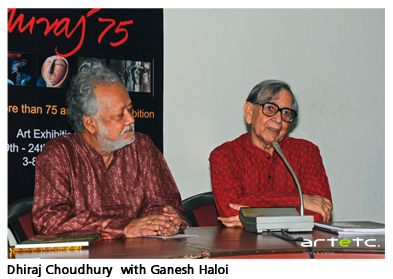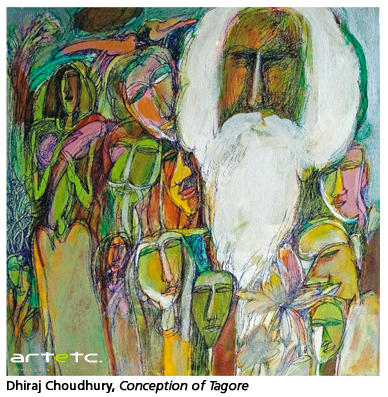- Publisher's Note
- Editorial
- The Enigma That was Souza
- Progressive Art Group Show: The Moderns
- The Souza Magic
- M.F. Husain: Other Identities
- From All, One; And From One, All
- Tyeb Mehta
- Akbar Padamsee: The Shastra of Art
- Sensuous Preoccupations of V.S. Gaitonde
- Manishi Dey: The Elusive Bohemian
- Krishen Khanna: The Fauvist Progressive
- Ram Kumar: Artistic Intensity of an Ascetic
- The Unspoken Histories and Fragment: Bal Chhabda
- P. A. G. and the Role of the Critics
- Group 1890: An Antidote for the Progressives?
- The Subversive Modernist: K.K.Hebbar
- Challenging Conventional Perceptions of African Art
- 40 Striking Indian Sculptures at Peabody Essex Museum
- Tibetan Narrative Paintings at Rubin Museum
- Two New Galleries for the Art of Asia opens at the Museum of Fine Arts in Boston
- Raphael, Botticelli and Titian at the National Gallery of Australia
- The Economics of Patronization
- And Then There Was Zhang and Qi
- What Happened and What's Forthcoming
- Random Strokes
- Yinka Shonibare: Lavishly Clothing the Somber History
- A Majestic “Africa”: El Anatsui's Wall Hangings
- The Idea of Art, Participation and Change in Pistoletto’s Work
- On Wings of Sculpted Fantasies
- The Odysseus Journey into Time in the Form of Art
- On Confirming the Aesthetic of Spectacle: Vidya Kamat at the Guild Mumbai
- Dhiraj Choudhury: Artist in Platinum Mode
- Emerging from the Womb of Consciousness
- Gary Hume - The Indifferent Owl at the White Cube, London
- Daum Nancy: A Brief History
- Experimenting with New Spatial Concepts – The Serpentine Gallery Pavilion Project
- A Rare Joie De Vivre!
- Art Events Kolkata-December 2011– January 2012
- Art Bengaluru
- Mumbai Art Sighting
- Delhi Dias
- Musings from Chennai
- Preview, February, 2012- March, 2012
- In the News-January 2012
ART news & views
Dhiraj Choudhury: Artist in Platinum Mode
Issue No: 25 Month: 2 Year: 2012
by Rita Bhimani
 The setting was the vast tranquil azul primario waters of the Calcutta Rowing Club where Dhiraj Choudhury, in celebration of his 75 years, had involved an atelier of artists—more than 50 of them. To sculpt, draw, paint, for three days at an art camp, where camaraderie turned out to be the main colour, and creativity followed closely, capturing mood, moment, and memories.
The setting was the vast tranquil azul primario waters of the Calcutta Rowing Club where Dhiraj Choudhury, in celebration of his 75 years, had involved an atelier of artists—more than 50 of them. To sculpt, draw, paint, for three days at an art camp, where camaraderie turned out to be the main colour, and creativity followed closely, capturing mood, moment, and memories.
A prevalent notion about art workshops is that they do not necessarily throw up good work, time constraints being the negator of meaningful output. But through my visits and reconnaissance over three days, this turned out to be more of a misconception. Veteran sculptor Uma Siddhanta felt: “I think you can create excellent work in a camp, given the deadline, the atmosphere of work all around, the inspiration of creative thought that runs through participants. And your own challenge to give of your best in a limited time span.”
At the camp, while Uma Sidhanta worked on an elongated pig sculpture and painted, too, other sculptors Tarak Gharai and Niranjan Pradhan were intensely eking shapes out of wax sheets to be ultimately cast in bronze, there were art college mates Shyamasree Basu depicting a pensive mood in acrylic on canvas, Shanu Lahiri painting a tiger guarding his jungle preserve. And the rest scattered all over, near the swimming pool, under the trees, by the lake, drawing their inspiration from within and from nature.
The proof of all the work at the camp could be seen in the second part of the Platinum birthday celebrations of Dhiraj Choudhury, held at the Academy from the 19th to the 24th of November. In addition to his hundred works, many of them from the sixties, and some vibrant current ones, and 50 sculptures and works on wood, he had 100 participants in the exhibition whose work has been on display and sale. It is truly the mark of a man of vision and a painter of class, who can step out of his ego and conceive a world where his own creativity blossoms, but never edges out the aspirant or the struggler who might want to make a mark.


The whole Academy was awash with colour—with all the galleries full of the work of Dhiraj Choudhury and a hundred other artists. Dhiraj Choudhury’s own work-–drawings, paintings, water colours, sculptures, ceramics, and some intensely personal renderings of Tagore (Prasno, Ekla Chalo, Urvashi) show the development of the artist and his various phases and periods. The socio- political environment has had a huge impact on his visual language. In his own words: “Whatever I have lost or gained, my personal triumphs or failures, my emotions—love, passion, anger, joy–my fears and insecurities, my hopes, have all found expression in my creative endeavours.”
The exhibition moves to Delhi this March, 2012 at Art Konsult.
While it has been a glorious celebration and a retrospective of an artist who has been teacher, publisher, artist, mentor and creator of various art movements, it is his unstoppable zest at this point of time to explore newer mediums of art which proves, in Ganesh Haloi’s words, that Dhiraj is a present continuous tense.